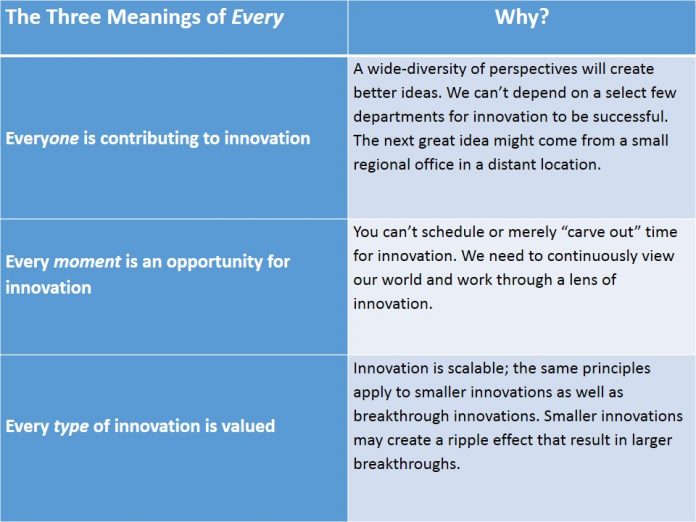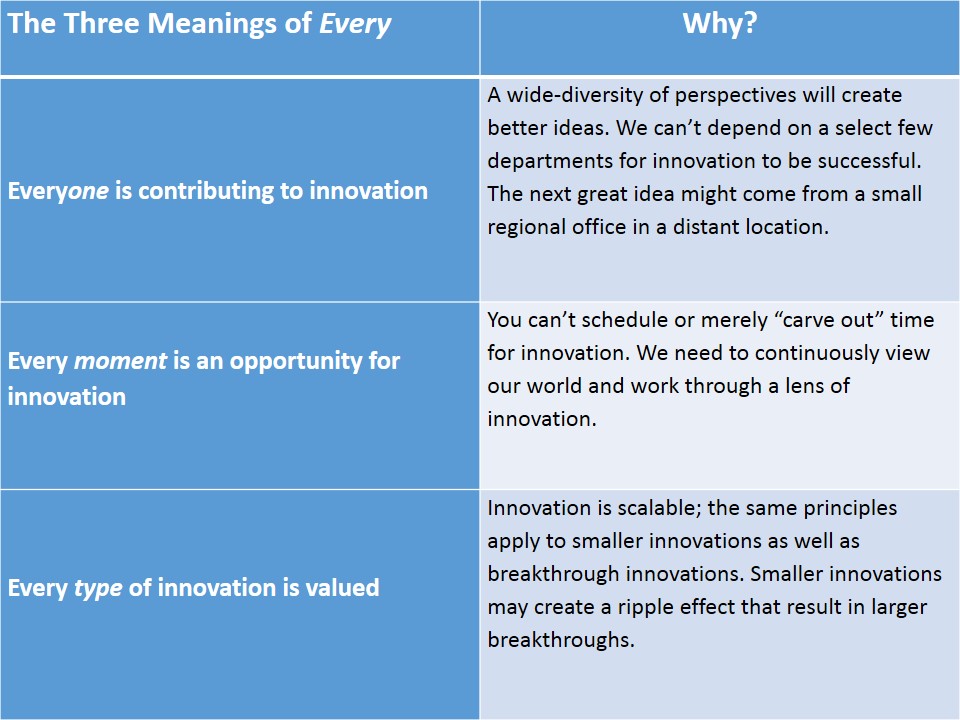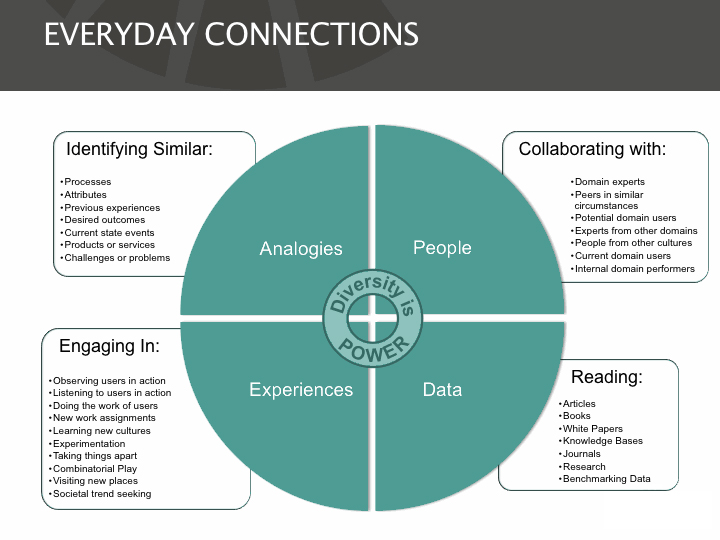
A custodian working in a restaurant that is part of a global company has developed a strong sense for what customers need and expect. He feels it is part of his job to help create a fun, family-oriented dining experience. Recently he observes kitchen staff filling French fry containers to capacity, yet watches as fries regularly end up in the garbage cans. He often overhears customers mention that while the food is good, it is just too much for one sitting. He also finds he is spending much of his time emptying trash cans, and the culprit is invariably people throwing away fries. He brings an idea to his boss: Could the staff reduce the portion of fries served per container by just one ounce? His boss appreciates the idea and tries it out. Immediately, the amount of fries being thrown out is reduced. Compliments about cleanliness are overheard and shared in customer satisfaction surveys. In addition, the time it takes the custodian to properly clean the restaurant is reduced significantly. This idea is standardized across the dozens of restaurants across the company worldwide. At the end of the year, Finance reports a savings of several million dollars per year.
The ability to continuously generate new ideas and innovations has become imperative as markets grow more global, open, and competitive, and as customer expectations grow more diverse and demanding. Organizations are realizing they must commit to innovation as a key strategy for success and expect and support innovation from everyone. Our world demands a new perspective—a new brand—of innovation, one that is broader and more inclusive. Our world demands Everyday Innovation.
Everyday Innovation occurs when everyone in an organization is actively and continuously supported, encouraged, and contributing toward the generation and implementation of new ideas and innovations of all types, from small to transformational, to improve our organizations and our world.
The term “every” has three meanings in the context of Everyday Innovation:
- Involving everyone in innovation
- Having an innovation mindset at every moment
- Valuing every type of innovation, from small to transformational (see Figure 1).
Figure 1

To drive Everyday Innovation, two kinds of capabilities must be developed: people and organizational. The latter is important because all too often, all of the talk about innovation fails to sufficiently address the organizational support processes needed to encourage, expect, reward, and drive innovation. Most organizations are not designed to innovate, and you shouldn’t expect an organization to do what it is not designed to do.
On the people side, one of the key capabilities is the ability to view the world and our work through an “innovator’s lens.” The ARC Model represents this lens, which is focused on creating. ARC stands for: Acknowledge-Reframe-Connect. When Innovators “ARC,” they acknowledge their current circumstances, reframe these circumstances within the context of a desired outcome, and connect to a diversity of ideas and experiences to bring the desired outcome to life. Although the ARC elements are presented sequentially, “ARCing” is iterative. With practice and experience, acknowledging, reframing, and connecting occur almost simultaneously, becoming instinctive and natural.
Acknowledge: Contrary to the myth that innovators have their “head in the clouds,” innovators skillfully work to understand their current circumstances and realities.
- Clearly understand and analyze your current circumstances—both positive and negative.
- Identify all of the stakeholders involved in these circumstances.
- Identify the consequences of current challenges and issues, including any ripple effects, on the various stakeholders.
Reframe: Innovators reframe their current circumstances in the context of the desired outcomes they ultimately want to create. Innovators know problems are real but do not make them their center of focus. Problems are viewed and addressed only in the broader context of a desired outcome.
- Imagine that your challenge or issue does not exist and determine what you want to achieve or see in its place.
- Then ask: Why you want to create that outcome?
- Continue to ask this question until you land on the “right level of detail” around the ultimate desired outcome you want to create (see Figure 2).
Figure 2: Reframing the French Fry Problem

Connect: Innovators connect to a diversity of perspectives to generate ideas and to bring their ultimate desired outcomes to life (see Figure 3).
- People: Seek a diversity of input and feedback from others around your ideas, both internally and externally. Everyday Innovators realize they may only have a “piece” of an idea that, when combined with someone else’s, may turn into something powerful.
- Data: Seek out knowledge and ideas documented in books, articles, and other data sources. Innovators know that reading what others have written or researched is an excellent way to spark ideas.
- Experiences: Participate directly in activities related to your ideas and desired outcomes. For example, seeking new ideas around restaurant serving techniques might involve performing the role of restaurant server, interviewing servers, or observing servers in action.
- Analogies: Ask, “What other desired outcomes, ideas, jobs, or knowledge ‘domains’ have attributes similar to mine?” Innovators are skillful at making associational connections. For example, when seeking associations to serving in a restaurant, innovators might make connections to others who “serve,” such as accountants, nurses, or Peace Corp volunteers. Great associations often can be made between seemingly unrelated ideas.
Figure 3

In today’s world, many organizations are experiencing increasingly competitive markets, diverse and demanding customers, profitability and growth challenges, and decreasing employee engagement. In many cases, cost-cutting measures have reached the point of diminishing returns. The need for continuous and sustained innovation has never been greater, regardless of organizational size or industry. Leaders are recognizing that new innovation capabilities are needed, and like any skill, innovation can be learned and developed with practice and proper organizational support. Leaders also know that their organizations now must commit to innovation as a key strategy for success and encourage, expect and support everyone to be active contributors toward innovation and growth. The world now demands Everyday Innovation.
Terry M. Farmer, Ph.D., is co-founder of EiQ. Farmer has more than 25 years of experience in the area of performance improvement, instructional design, strategy, and organizational development. He has held several internal consulting and leadership positions within several organizations across multiple industries, including IBM, Ernst & Young, Rubbermaid Incorporated, The Walt Disney Company, Nationwide Insurance, and Eaton Corporation. Farmer has a Master’s degree and Ph.D. in Instructional Systems Technology from Indiana University.
Xavier Butte is co-founder of EiQ and has more than 15 years of experience as a leader and strategic advisor focused on building individual and organizational performance capabilities. Butte has held various leadership positions, including leading the Nationwide Performance Improvement Organization and the start-up of the Strategic Change Leadership function of the Business Transformation Office at Nationwide, also as Director of Performance and Technology at Nationwide. Butte has a Master’s degree from the Fisher College of Business and a Bachelor’s degree in Organizational Communication from The Ohio State University.



